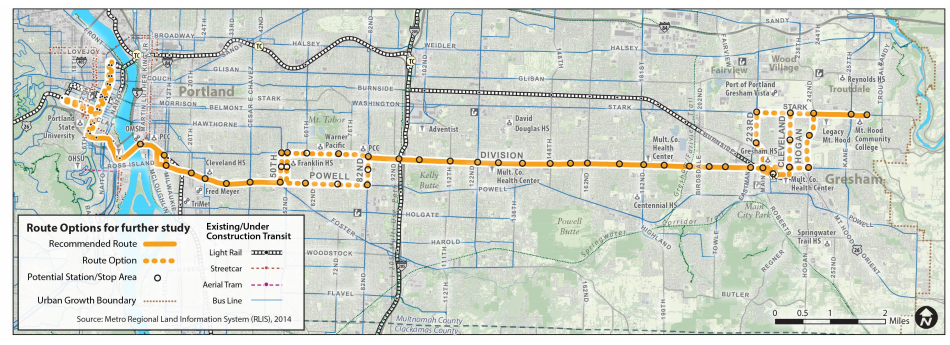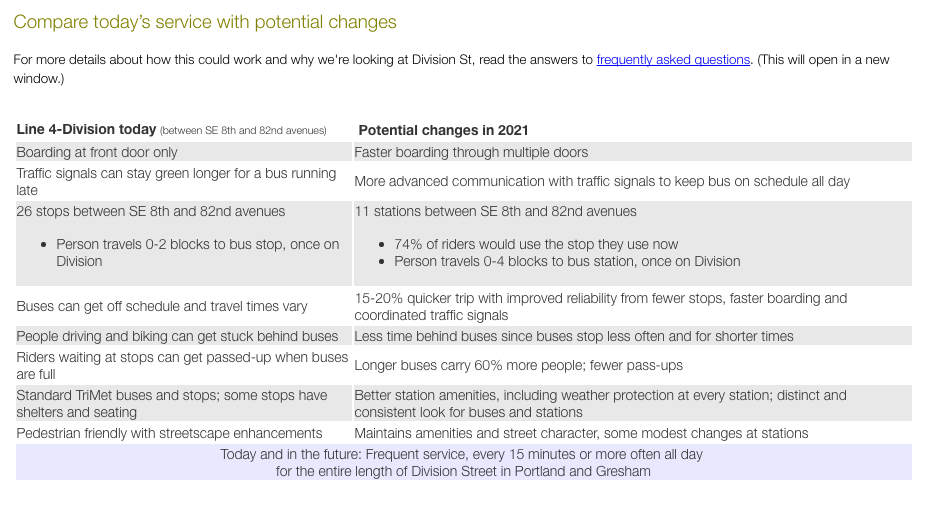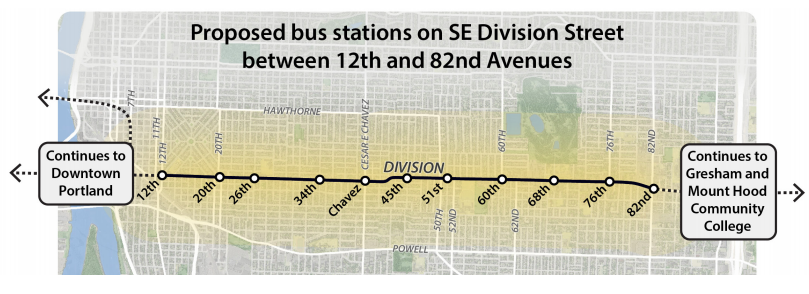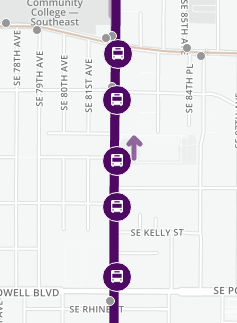For the past few years, planners at the transit agency TriMet and MPO Metro in Portland have been carefully shepherding the development of a new sort of transit project for the city. It’s turning into a new sort of transit project, period — one that doesn’t fit in the usual categories and that we will need a new word for.
The Powell-Division Transit and Development Project extends from downtown across Portland’s dense inner east side and then onward into “inner ring suburb” fabric of East Portland — now generally the lowest-income part of the region– ending at the edge city of Gresham. It was initially conceived as a Bus Rapid Transit (BRT) line, though one without much exclusive lane. It would be a new east-west rapid element in Portland’s high-frequency grid, and also serves a community college and several commercial districts.
(Full disclosure: JWA assisted with a single workshop on this project back in 2015, but we haven’t been involved in over a year.).
Below is a map of how the project had evolved by 2015, with several routing choices still undetermined. From downtown it was to cross the new Tilikum bridge and follow Powell Blvd. for a while Ironically, as inner eastside Portland began to be rethought for pedestrians and bicycles, decades ago, Powell was always the street that would “still be for cars.” To find most of the area’s gas stations and drive-through fast food, head for Powell. As a result, it’s the fastest and widest of the streets remaining, but correspondingly the least pleasant for pedestrians.
Half a mile north is Division Street. For the first few miles out of downtown, Division is a two lane mainstreet, and it’s exploded with development. It’s on the way to being built almost continuously at three stories. Further out, Division is one of the busier commercial streets of disadvantaged East Portland, though still very suburban in style as everything out there is. (For an amusing mayoral comment on that segment, see here.)
Because dense, road-dieted Division is very slow close to the city but wide and busy further out, the project began out with the idea of using Powell close-in and then transitioning to Division further out, as Division got wider, though of course this missed the densest part of Division, which is closest-in.

However, very little of the corridor would be separated from traffic. While this project was never conceived as rail-replicating, it was based on the premise that a limited-stop service using higher-capacity vehicles, aided by careful signal and queue jump interventions, could effect a meaningful travel time savings along the corridor, compared to trips made today on TriMet’s frequent 4-Division. That line runs the entire length of Division and is one of the agency’s most productive lines, but it struggles with speed and reliability.
As it turned out, though, the travel time analyses showed that from outer Division to downtown, the circuitous routing via Powell cancelled out any travel time savings from faster operations or more widely spaced stops.
As a result, planners looked at a new approach, one that would seek to improve travel times by using inner Division, which had previously been ruled out. Inner Division is a tightly constrained, 2-lane roadway through one of the most spectacularly densifying corridors in Portland, and one that is rapidly becoming a prime regional dining and entertainment destination. This development has led to predictable local handwringing about parking and travel options. Here’s what that alternative looks like:


Proposed Division station locations

Current 4-Division eastbound stops
The new plan is basically just stop consolidation with some aesthetic and fare collection/boarding improvements. But the stop consolidation would be dramatic. Note that one numbered avenue in Portland represents about 300 feet of distance, so the new spacing opens up gaps of up to 2400 feet. If you’re at 30th, for example, you’d be almost 1/4 mile from the nearest stop.
Such a plan would be controversial but quite also historic. It’s a very wide spacing for the sole service on a street. On the other hand, the wide spacing occurs on a street that is very, very walkable — one of the city’s most successful “mainstreets” in fact. And it’s basically the only way to optimize both speed and frequency on a two-lane mainstreet like inner Division.
At this point, it would be strange to call this project “BRT” (Bus Rapid Transit); even the project webpage refers to this alternative as “Division rapid bus”.
Disappointing as this will be to those who think BRT should emulate rail, it has one huge advantage over light rail. In Portland, surface light rail tends to get built where there’s room instead of where existing neighborhoods are, so it routinely ends up in ravines next to freeways, a long walk from anything. This Division project now looks like the answer to a more interesting question: What is the fastest, most reliable, most attractive service that can penetrate our densest neighborhoods, bringing great transit to the heart of where it’s most needed?
This is such a good question that we shouldn’t let arguments about the definition of “BRT” distract from it. Because it’s not a question about technology. It’s a question about people.

Line 72 stopping pattern (Powell to Division, approx. 0.5 mi)
Upgrading the 4-Division to a rapid bus line (without underlying local service, which is impossible due to the constrained roadway) should present a real improvement in quality of service (in terms of capacity using the larger vehicles, and in a 20-25% travel time savings), while at the same time being easier to implement and less disruptive to existing travel patterns.
It also provides a template for TriMet to consider stop consolidation and frequent rapid service on other corridors like the aforementioned Line 72. Rather than seeing this as a failure to design a rapid transit project, perhaps we can celebrate a process that has steered away from a path that would have resulted in a disappointing outcome, towards a more limited, more economical, but still meaningful improvement for riders.
You’re right, we shouldn’t let terminology stand in the way of a good plan. And to my inexpert eyes, this plan looks very good indeed. Adding a maximum of 3 minutes to walking time seems a small price to pay for faster and more reliable service.
But my inner technical editor will cringe every time this line is called “bus rapid transit.” And they will call it that. Oh well.
I think this raises an important point. Rapid service is important, but (I think) it’s more important to put stations where pedestrians want to be, and to think of transit as an extension of the pedestrian mode. There’s a lot of ideology opposed to compromising on exclusive lanes, but urban and pedestrian advocates need equal opposition to routing compromises that miss pedestrian centers in pursuit of a narrow definition of rapid transit.
Ugh, stop spacing – everyone wants a stop near them and no-one wants to be ‘ the loser ‘ when it comes to cutting stops. It is going to be a nightmare to have existing stops cut.
However, there is one way to do it. Run the new service with the limited stops first. This will cause passengers to shift to the new service, reducing support for the slower old service.
Then after some time (months) – cut!
Regarding eliminating stops, you just need to go and do it. Make sure there’s adequate sidewalks for getting to the remaining stops, possibly provide some better amenities there, and promote the faster travel time and smoother ride. Point out to those riders that in exchange for giving up a little something, they are getting a large return. Ask them if they really want a bus that stops closer to them but isn’t as useful due to the slowness. Lastly, consider allowing those who really need it to get off where they want away from designated stops.
Stop consolidation and spacing are always tough questions. In LA, there are often widely spaced stops that make the transit harder to use because the spaces in between are not always very walkable. In San Francisco on the other hand, there is now an effort to speed up service and eliminate some redundant stops but that is not going to be easy going. Hopefully Portland has found a new successful hybrid way to close some of this gap.
Seems like a great, common-sense plan. It’s not all or nothing though: worst-case scenario, if the outcry that the distance between stops is too great becomes too much for Tri-Met to handle, relocating and respacing stops in the two segments with the greatest distance between stops could eliminate the most impactful consolidations while adding only two stops total. It’s good that Tri-Met is trying to be as aggressive as possible with consolidation, and hopefully it is approved, but my point is there is room for a little strategic retreat that would still accomplish the vast majority of the proposed improvements.
This reminds me a lot of what CapMetro in Austin is doing/proposing doing with its “BRT” metrorapid.
They started off with fairly limited stops for the “BRT”, and retained local service (with some frequency cuts) on all the existing stops.
They’re adding a few BRT stops next year, but are proposing much larger changes:
Completely eliminating the locals, and infilling “BRT” stops at 1/4 to 1/2 mile spacing. And then running that at 7-10 minute frequency during the day, and reduced frequency 24 hours.
Nice plan, but why is it projected for 2021? It may take time to acquire the larger buses, but it looks like all the other changes should be possible to implement in a much shorter time frame.
Looks like a great plan, and I think the major features would work well in some of our routes here in Halifax, NS. We have lots of routes in the urban core that perform well, but run on tight two way roads – no chance at all for continuous transit lanes.
Great article! But aren’t Portland city blocks ~200 feet rather than 300 as listed in the article. A minor detail but it could make a big difference in your point about stop spacing; which I wish they would do with all the buses in town. 400 feet (2 blocks) is NOT enough distance before a stop.
Visiting Portland I rode the 4 yesterday to 74th. I actually wanted 76th and I figured I would pull the stop cord about three (very short) blocks away at 73rd, but then the driver pulled over at 74th, which apparently was yet another stop. There’s a stop like every 400ft. I’m sure shaving off a few minutes through stop consolidation would help that route, and should be done sooner, like right away. But up to 60th Division is a very narrow, crowded street with cars making turns and parallel parking, which forces the bus to wait. It has so many marked, uncontrolled crosswalks for which cars and buses have to stop frequently (which is a feature of Division for urbanist principles and not a drawback). Other than stop consolidation I don’t know how you would speed up that bus without interfering with the urban character of Division or restricting parking and turns.
Are they introducing bus lanes on the 4 lane bits though? I can understand the routing through the main street but that needs to be made up for by improved journey times through the less dense suburban areas.
There are some smart suggestions here to run the Rapid with wider stop spacing, and serve all the existing stops with the Local. Then as ridership naturally shifts to the Rapid, cut the Local.
A great idea…on a multi-lane street. The really interesting thing about this proposal is that there is one very narrow lane in each direction on inner Division. So it’s a Rapid, or it’s a Local. But it can’t be both!
Regarding stop spacing in Portland, TriMet is a little unusual in not having a stop spacing policy. (Not that agencies with stop spacing policies necessarily follow them.)
This is a VERY BAD idea! I drive for Trimet and with all due honesty no one have asked Trimet operators who drive the Line 4 their input. For one thing the Line 4 on Division is hampered with some of the toughest and most tight driving quarters of any streets in Portland especially on SE Division between SE 11 and SE 72nd. It is tough enough navigating a 40 foot bus in rush hour through a sea of people, delivery vehicles, rush hour traffic, school kids, bicycles, etc. To think that just spacing bus stops further apart and adding a 80 foot articulate bus through this sea of chaos in the future -when the number of people and cars will only get more DENSE along this corridor in the future with Portland’s growing population- is foolish. Currently, if a 40 foot bus stops to service a stop cars behind the bus can still go around the bus with adequate visibility. That will not happen when you put a 80 foot articulated bus along this corridor, because it will be unsafe and impossible for motorists and bicyclist to see beyond the articulated bus. Every time the 80 articulated bus stops to service stops – the articulated bus will create a massive clog which will create a long line of cars and bicyclists behind it. Its like driving or bicycling behind a max train on SE Division. This is compounded by the fact that Line 4 buses services a large contingent of wheel chair, disabled, elderly, homeless, and vulnerable riders which invariably causes it to perform more stops irrespective of whether you space the bus stops. Additionally, if the 80 foot articulated bus breaks down along SE Division then what? Unlike a 40 foot bus where its easy for motorists and bicyclists to maneuver around and mechanics to dislodge the bus. A 80 foot bus the is the size of a max being stuck on the busies corridor in Portland will be a bottle neck NIGHTMARE!
These are but the most extreme examples of how the 80 foot articulated bus will clog SE Division without pointing out the many minor issues that cause drivers like myself to hold up or delay service with the current 40 foot buses which are smaller. The minor issues I face daily as a driver will only be compounded by the 80 foot articulated bus. Just facts!
My feelings is the people making this decision knows the 80 foot articulated bus will cause nightmarish congestions and hopes the congestion will drive motorists and bicyclists -who currently use SE Division will be forced- to find alternative routes.
Yes, these are mostly good points. But you know: it may be a bad idea, but it’s less bad than all the other ideas, at least until someone comes up with the money for a subway. There’s not much space on Division, but lots of demand, and yet the development is predicated on high transit ridership.. What would you do?